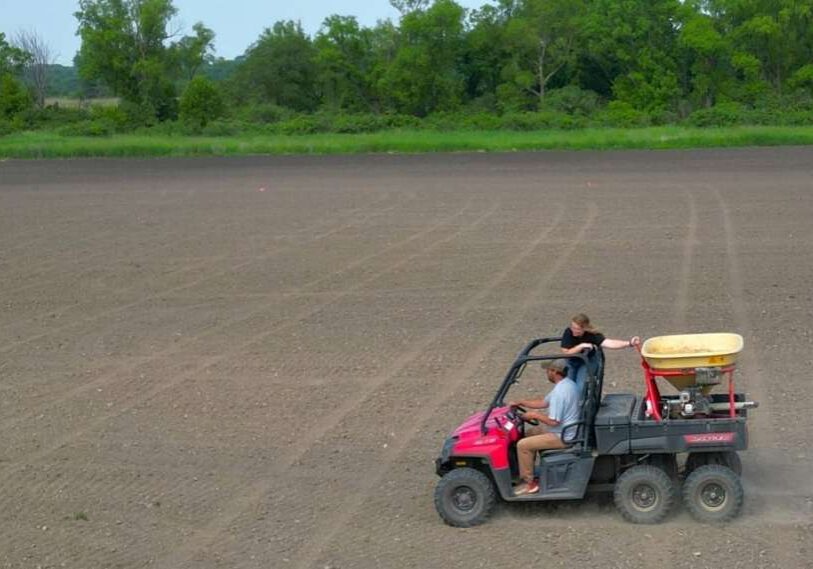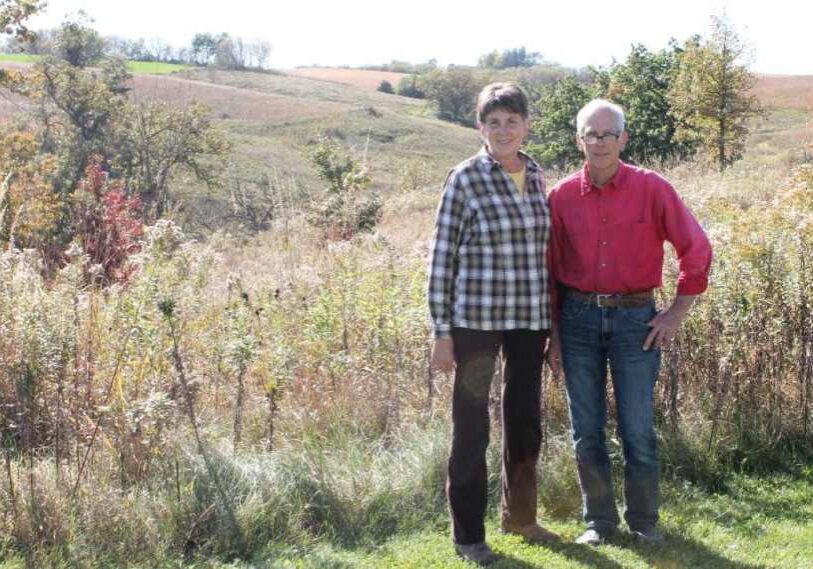Water — A Resource in Crisis

LEWISTON — One of the first people to sign in for a public meeting on Winona County contaminated water was Alex Romano carrying her curly-haired daughter, Ruth, 7 months. Mom worries about nitrates in the water Ruth and her sister, Mollie, 2, drink at their rural Lanesboro home.
“First and foremost, I’m a mom of two young girls,” she said before the May 22 meeting in Lewiston. “I’m here to learn what’s going on with the water and what we can do about it.” So far, her water has tested well below the federal threshold of 10 parts per million, but she worries that with farming becoming oriented to row crops and large feedlots, that could change.

Approximately 100 people attended the water quality meeting in Lewiston, Minnesota. (Photo by John Weiss)
Also, she works for the Land Stewardship Project, which advocates for changes in farming practices, and “I think there are solutions out there” based on sustainable development. “I think agriculture can be part of it.”
At the meeting, attended by about 100 people, she heard two anglers and three experts share those perspective, and more, on the nitrate issue. It was put on by the Winona County Clean Water Coalition and coordinated by the League of Women Voters; how they saw the situation was summed up neatly in the title: “A Resource in Crisis.”
Well contamination
Nitrates, mostly from farms according to speakers, as well as some chemicals that go with them, are increasing contamination in more wells and surface water in Winona County. To worsen problems, research is showing that nitrates are more of a health worry at lower levels than previous thought, including for increased cancer risk.
Speakers’ perspectives on contamination:
Leland Stoe lives in the Twin Cities metro and also has a place at Rush Creek near Lewiston. He, his son and grandson regularly fly fish the blue-ribbon trout stream; in fact, his grandson caught his first trout there recently, But it was near his land that something went wrong nearly a year ago, killing about 2,500 fish, mainly trout. While the kill was investigated by three state agencies, the precise cause was not determined. But they concluded “contaminated runoff following a significant rainfall event on July 23 likely caused the fish kill.”
Stoe was shocked by news of the kill. “We took so much for granted on that day,” he said. He worries that he won’t be able to pass on great memories and a clear, trout-filled stream, to his son and grandson. “Places like Fish Creek matter,” he said.
Monta Hayner is a skilled trout angler who works with her brother, Melvin Hayner, at the Driftless Fly Fishing Company in Preston. She offered a wider view of trout fishing, stressing its economic importance. A study by Trout Unlimited found trout fishing annually brings $1.1 billion into the Driftless Region that includes southeast Minnesota, southwest Wisconsin, Northeast Iowa and a bit of Illinois. Minnesota makes up about 20 percent of that region. (A later TU study found the amount had increased to $1.6 billion in 2016.)
Those from outside Minnesota are coming from Iowa, Wisconsin, Michigan and the Chicago area, she said.

Paul Wotzka, an expert on ground water and pollution, talks about problems with nitrates and other chemicals from farms. (Photo by John Weiss)
Paul Wotzka farms organically near the mouth of the Whitewater River, a major trout fishing area, and is a geologist and a founder of the Minnesota Well Owners Organization. He laid out the nitrate problem that seems to be getting worse especially in western Winona County. Our drinking water “stinks” and the trout streams are sick, he said. Some streams are acutely damaged, as shown by fish kills, and streams overall are impaired by nitrates, e Coli, other pollutants and sediment, he said. But for him “the drinking water, in my mind, always comes to the top … “that is THE most important thing for everyone here.” The main impairment in Lewiston, Bethany and Altura are nitrates, he said.
In Utica, its two city wells were properly constructed and maintained but the levels of nitrates and chloride continue to rise, despite many new laws and regulations that should have slowed or stopped the increase, he said. Townships in western Winona County have the highest concentration of excess nitrates in private wells, he said. And those wells also have concentrations of herbicides used on row crops such as acetochlor, alachlor and atrazine, he said.
Part of the problem is that the area is in the karst area with little topsoil over porous limestone and sandstone. Water on the surface can quickly end up in the ground water and ground water can quickly come to the surface through thousands and springs and seeps. Winona County also has about 1,400 sinkholes where rock below the surface has given way so the water goes directly from the surface into the ground water, he said.
Nitrates in that water come mostly (about 90 percent) from farm runoff, manure applications or crop fertilizers. But what many people probably don’t realize is that other farm chemicals sometimes, or always, are with nitrates, Wotzka said. The townships with the worst nitrate problems in wells are also those with the most sinkholes, he said.
Owners of private wells should test their water, though they aren’t mandated to do it, he said. “I’m telling you, you are on your own,” he said. “Tested private wells showed 19 percent were above 10 ppm.”
Dr. Aleta Borrud, a retired doctor and community healthcare advocate from Olmsted County outlined problems with nitrates, including a greater chance of cancer. She began with “this is personal for me.”
Nitrates are a natural substance found in our diets but they come with things that counteract them, she said. Others come with meat but some also comes from bad water. And that is what she concentrated on. She stressed that nitrates can’t be seen, smelled or tasted by humans. “You don’t know unless you test,” she said.
Enough nitrates in the first six months of a baby’s life can lead to blue-baby syndrome that can kill them by replacing hemoglobin with nitrates so blood can’t carry oxygen, she said. But there can be more problems if mothers drink high-nitrate water when pregnant such as problems with the baby’s spine, limbs and other birth defects, as well as a greater chance for spontaneous abortions, Borrud said.
Furthermore, nitrates are a “probable carcinogen” in drinking water,” she said. Women have a greater chance with water at 5 ppm or more while men can get more colorectal cancer at a level as low as 1.27 ppm. she said.
To put it succinctly, the safe federal level, set in 1962, is not safe, she said. And people are drinking more water with more nitrates because the amount in urine is rising.
Finally, she said atrazine, another chemical that can come from farms, is more toxic than once thought.
Carly Griffith of the Minnesota Center for Environmental Advocacy said her group, along with 10 other groups, asked the federal Environmental Protection Agency in April to intercede in the eight southeast Minnesota counties with karst.
The State of Minnesota is responsible for implementing federal water laws, but the EPA has emergency powers to intervene. The petition notes that fertilizer and manure application can affect about 380,000 people who rely on about 80,000 private wells for drinking water. Furthermore, like Dr. Borrud, she said research has shown more risks at lower levels of nitrate. There is not enough regulation of industrial-scale agriculture or big feedlots and,“Residents have to pay the price,” Griffith said.
Audience dialogue following speaker comments: Wotka said agriculture is both part of the problem and part of the solution. A major fish kill in the nearby South Branch Whitewater River several years ago killed about 10,000 fish, he said. Manure spreading before a rain was implicated, he said. Farmers can use forecasts to find out when to spread manure, he said. “Be cognizant of the tools that are available.” Aquifers can be fixed, he said. They have seen radical drops in nitrate levels but “you have to use some drastic land-use changes.” After the meeting, Romano was happy with what she heard and ready to help change. “I thought it was excellent, unprecedented and sobering,” she’s said. “It’s got me pretty activated to get this word out to as many people as I can … it gets me energized.” Having daughters helps push her, she said. She wants to see healthy soils and healthy food for her children. “I don’t want to move because we can’t drink our water; that is the future we are looking (at).” She also believes that more nitrates, and other chemicals, are not inevitable, that farms don’t have to be only row crops or with large animal confinement barns. “Agriculture done right can actually clean up the water,” she said. It can also recharge ground water by planting cover crops and taking other measures that protect the soil, keeping it and chemicals there instead of in the water. She’s talked with older farmers who remember when farms were more diversified, crops were rotated and cattle grazed on the land. They told her how they could once stand on their porch and see 10 small dairies. “And they (dairies) are all gone,” Romano said. The animals are gone, the hay ground is gone.
Additional articles on Water quality published by Root River Current: Minnesota Launches First Phase of Nitrate Mitigation Plan Southeast Minnesota Runoff Pollutes Beyond Local Area Minnesota Nitrate concerns inspire Iowa groups to seek EPA help Nitrate and Water Issue Proposals Addressed by 2024 Minnesota Legislature State Officials: January 2024 Plan Addresses Nitrate Contamination Issues Local Forums, EPA Raise Questions About SE Minnesota Water Quality … State Agencies Respond What Happens When Feedlots Get Bigger in Karst Country?






